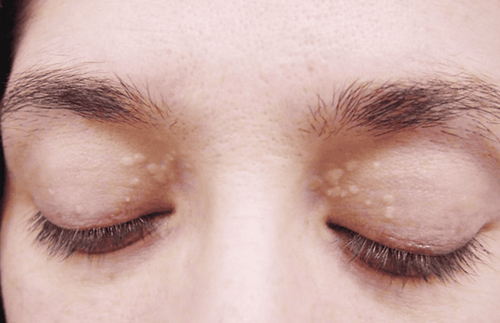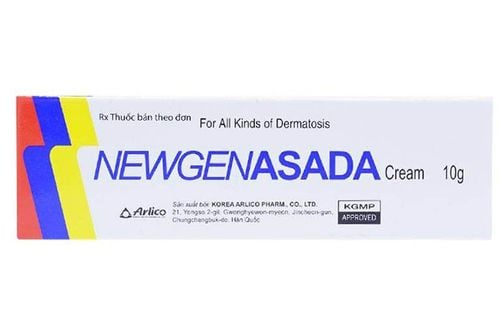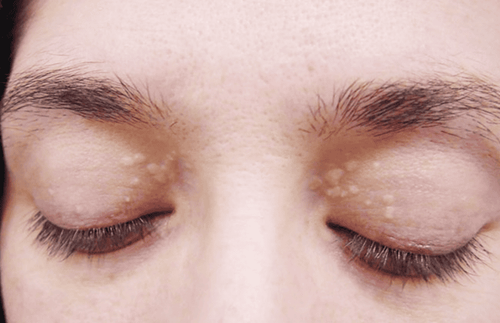This is an automatically translated article.
Syringoma is a small benign tumor that is easy to see because it usually grows on the upper cheek or lower eyelid. Skin lesions from sweat duct tumors are usually harmless because they are the result of cells from the sweat glands being overactive, which can occur at any age. The cause of sweat gland tumors can be due to genetic abnormalities or metabolic diseases inside the body.1. What is a sweat gland tumor?
Sweat duct tumors are the name given to tumors caused by benign growths of sweat glands. They appear as small 1-3 mm brown, yellow or pink bumps (papules) that tend to appear in clusters.Distribution of sweat duct tumors usually arise around the eyes or on the neck, less commonly in the armpits, abdomen and genitals. Rarely, sweat duct tumors can occur on the scalp, causing hair loss which is not uncommon. Women are usually more affected than men. In addition, sweat duct tumors tend to have their first flare-up in adolescence, but can begin at any age.
In most cases, sweat duct tumors are not dangerous. If they are cosmetically damaging, a dermatologist may use destructive treatments, including measures such as laser therapy, dermabrasion, or electrocautery. However, the indications for intervention often have to be carefully considered because the skin manipulation process can cause scarring, moreover, even with treatment, the sweat duct tumor has a very high chance of recurrence.
U tuyến mồ hôi thường mọc ở má trên hoặc mí mắt dưới
2. What are the symptoms of a sweat gland tumor?
2.1 History Patients with sweat gland tumors are usually asymptomatic. However, in rare cases, a sweat gland tumor can cause itching, especially when a sweat gland tumor is in the armpit or a sweat duct in the vagina and when the body sweats a lot.In rare cases, the patient may have a family history of similar lesions. On the other hand, sweat glands can also be included in Brooke-Spiegler syndrome, an autosomal dominant disease.
In addition, other associations with sweat gland tumors include Nicolau-Balus syndrome, characterized by milia and dermatophytosis, and Costello syndrome, which is characterized by various skin manifestations such as hyperkeratosis. , hyperpigmentation, papillomas, deep wrinkles, and neurological abnormalities. In addition, in rare cases, myeloma may be associated with multiple lipomatosis. The incidence of sweat gland tumors has a significant incidence associated with Down syndrome.
2.2 Characteristics of sweat glands are skin-colored or yellowish rashes, usually small in size with a diameter of less than 3 mm. However, rare cases of giant tumors have been reported. Tumors in an intimate area such as the penis or vulva often present as a hyperpigmented papule. Occasionally, the lesions may be translucent or cystic. The surface of a sweat gland tumor may be round or flat.
2.3 Location Sweat gland tumors often have many lesions at the same time, sometimes arranged in clusters and distributed symmetrically. Most commonly, however, the tumor is confined to the upper part of the cheek and lower eyelid.
Other characteristic sites of sweat glands are the armpits, chest, abdomen, penis, and vulva. Case reports have described tumors confined to the back of the hand.
2.4 Differential diagnosis from other skin lesions In rare cases, sweat glands may appear on the scalp and be associated with scarring alopecia. Clinically, sweat gland tumors sometimes need to be differentiated from basal cell carcinomas. If a sweat duct tumor appears on the trunk, it may resemble diffuse granuloma.

U tuyến mồ hôi thường gặp ở những người bài tiết mồ hôi nhiều
3. What causes sweat duct tumor?
Sweat glands can occur from any activity that increases sweat gland production. From there, these stimuli can lead to tumor growth. Furthermore, a number of other circumstances can affect the sweat glands and become the cause of an increased likelihood of developing tumors, including:Genetics. A person is more likely to develop ductal adenomas than others if a parent or any other close relative also has the condition. Down syndrome. A condition where people are born with an extra copy of chromosome 21 or trisomy 21. This can cause physical or mental disabilities. Diabetes. A metabolic disease characterized by high blood glucose levels due to insulin deficiency or increased insulin resistance in peripheral tissues. The hormone insulin secreted by the pancreas carries sugar from the blood into the cells and is used for energy or storage. Marfan syndrome. An inherited connective tissue disorder that affects the body's normal development. Some of the typical features include loose joints, large and flat feet, long fingers, and tall clams. Ehlers-Danlos syndrome. It is also an inherited condition that affects the connective tissue in skin structures, blood vessels, bones, and internal organs. In summary, sweat gland tumors are benign tumors of the skin that originate from the endodermal duct portion of the skin excretory glands. This skin lesion is more common in women than in men and usually arises during puberty or early adulthood. The typical features of sweat gland tumors are in the perioral and maxillary areas of the face, however, axillary sweat gland tumors or septum sweat duct tumors occasionally occur. Because the cause of sweat gland tumors is often due to systemic diseases, genetic abnormalities, or metabolic disorders, the treatment of this condition should be considered because of the high risk of recurrence.
Vinmec International General Hospital is the address for examination, treatment and prevention of diseases, including Dermatology. When performing the examination process at Vinmec, customers will be welcomed and used modern facilities and machinery along with perfect medical services under the guidance and advice of doctors. well-trained doctors, both at home and abroad.
Please dial HOTLINE for more information or register for an appointment HERE. Download MyVinmec app to make appointments faster and to manage your bookings easily.
Reference source: .aocd.org - emedicine.medscape.com - skinsight.com












